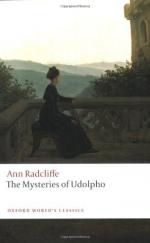|
This section contains 4,879 words (approx. 17 pages at 300 words per page) |

|
SOURCE: "Udolpho's Primal Mystery," in Studies in English Literature, 1500-1900, Vol. 23, No. 3, Summer, 1983, pp. 481-94.
In this essay, Fawcett discusses how symbols used in The Mysteries of Udolpho reveal to the reader the world of 1790s England and especially the condition of sexuality, in a way that confirms Blake's verdict that contemporary love is crippled by the struggle between desire and restraint.
In Ann Radcliffe's novel, The Mysteries of Udolpho, a daughter wishes to know the secrets of her father's past and to understand events which occurred twenty years ago, at the time of her own birth, but which her father has, on his deathbed, forbidden her to search out. Curiosity and taboo, desire and restraint—we readers are drawn into a magic circle of deathbeds and birth anxieties. Mrs. Radcliffe hints at a truth, at a scene to be re-animated; Emily St. Aubert, her main character, looks...
|
This section contains 4,879 words (approx. 17 pages at 300 words per page) |

|


